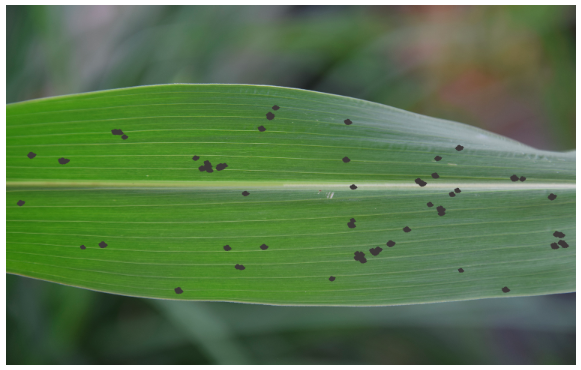By Alison Robertson
I continue to receive tar spot reports from across Iowa. Given the moisture we have had the past couple of weeks and the growth stage of the crop, this is not surprising. Tar spot development is favored by leaf moisture. As the growing season progresses, tar spot inoculum likely increases, the efficacy of many fungicides applied earlier in the season start to wane, and consequently we start to see more disease develop.
I have seen the best development of tar spot in my trials at the ISU Southeast Research Farm near Crawfordsville. Last week (August 18, 2022), average tar spot severity on the ear leaf of corn not sprayed with a fungicide was 1 to 2% (Fig. 1). The growth stage in my trials was R4-R5.
 Figure 1. Diagram showing 2% tar spot severity (from www.cropprotectionnetwork.org)There have been questions regarding an application of fungicide at R4 to R5 to protect the crop through physiological maturity. Dr. Darcy Telenko at Purdue University shared some fungicide data from her fungicide timing trials in Indiana over the past three years (2019, 2020 and 2021). She found that applications at VT to R2 were best, while little control was achieved with applications at R4 and R5 (See slide 40).
Figure 1. Diagram showing 2% tar spot severity (from www.cropprotectionnetwork.org)There have been questions regarding an application of fungicide at R4 to R5 to protect the crop through physiological maturity. Dr. Darcy Telenko at Purdue University shared some fungicide data from her fungicide timing trials in Indiana over the past three years (2019, 2020 and 2021). She found that applications at VT to R2 were best, while little control was achieved with applications at R4 and R5 (See slide 40). Slide 40
Slide 40Based on these data, if you have tar spot developing in your fields now, there is little you can do to control the disease this growing season. Rotating to soybean in the following year may help reduce the tar spot inoculum in that field. Another consideration is to plant a tar spot tolerant hybrid in that field and surrounding fields. Some seed companies will have tar spot scores for some of their hybrids in the coming year.






